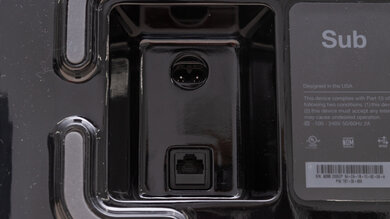The LG SN6Y is a fairly ordinary 3.1 channel soundbar setup. Its standard sound profile is fairly bass-heavy, although it lacks the deep rumble you find in action movie sound effects or electronic music. It has a dedicated center channel for clearer voices and dialogue, but it can also sound harsh. It does a poor job downmixing surround content, making the surround channels overly bass-heavy, and doesn't support Dolby Atmos. On the upside, it gets loud, and it has several sound customization features so you can tweak the way it sounds a bit to better suit your needs. You can also purchase a rear speaker kit to transform it into a 5.1 setup.
Our Verdict
The LG SN6Y is decent for mixed usage. This 3.1 setup has a bass-heavy sound profile out-of-the-box, but it struggles to reproduce the low thump and rumble in the low-bass. However, there are bass and treble adjustments to help you customize its sound. Thanks to its discrete center, it's a solid choice for vocal-centric content like TV shows. Unfortunately, there's no Atmos support, and its surround performance isn't the most impressive.
- Bass and treble adjustments.
- Gets loud.
- Lacks low-bass.
- No Atmos support.
The LG SN6Y is very good for vocal-centric content like TV shows. Thanks to its discrete center channel, voices are anchored to a pinpoint location in the soundstage. Dialogue is reproduced pretty clearly, though it can also sound a bit forward at times. That said, there's a dialogue enhancement feature available if you want to make voices more clear, and an auto-volume mode for watching TV at night.
- Bass and treble adjustments.
- Dialogue enhancement feature.
- Compression at max volume.
The LG SN6Y is satisfactory for music. Out-of-the-box, it has a fairly bass-heavy sound profile, and vocals and lead instruments sound a bit forward and harsh. Though it comes with a dedicated subwoofer, it still struggles to reproduce the thump and rumble in the low-bass, so it's not ideal for bass-heavy music genres like EDM. That said, there are some bass and treble adjustments if you want to customize its sound.
- Bass and treble adjustments.
- Gets loud.
- Lacks low-bass.
- Compression at max volume.
The LG SN6Y 3.1 is okay for movies. This 3.1 setup doesn't support Dolby Atmos content. While it can play surround content, it has to downmix it to stereo to play it, which doesn't sound very immersive. It also lacks low-bass, so you don't feel the deep rumble in action-packed scenes. That said, you can always upgrade it with rear speakers if you want a better surround performance.
- Bass and treble adjustments.
- Gets loud.
- Lacks low-bass.
- No Atmos support.
Changelog
- Updated Dec 17, 2021: Updated review for accuracy and clarity.
- Updated Aug 04, 2021: Added more information about auto-off and app device casting features.
- Updated Jul 23, 2021: Updated results as the bar doesn't support 4k passthrough.
- Updated May 06, 2021: Updated results to include the new companion app. Also, changed Rear Level Adjustment to 'YES'.
Check Price
Differences Between Sizes And Variants
The LG 3.1 channel 420w soundbar is available in 'Black'. You can see the label for the model we tested here.
If you come across another version of this soundbar, let us know in the discussions, and we'll update our review.
Popular Soundbar Comparisons
The LG SN6Y is a mid-range 3.1 soundbar, replacing the LG SL6Y. It's a passable soundbar but doesn't stand out much among the competition. It sounds alright overall but isn't as well-balanced as the Samsung HW-R650. While it supports the major surround sound formats, it doesn't support Atmos like the Sony HT-Z9F. That said, it does 4k passthrough and has several sound customization features, which many other 3.1 soundbars lack.
See also our recommendations for the best soundbars, the best soundbars with a subwoofer, and the best soundbars for music.
The Samsung HW-A650 is a bit better for mixed usage than the LG SN6Y. The Samsung is better built. It has a more neutral sound profile out-of-the-box, which some users may prefer. Also, it comes with a graphic EQ so you can customize its sound, which is handy.
The LG SN6Y and the LG SN8YG are similarly well-built soundbars, but the LG SN8YG performs slightly better overall. The SN8YG's wireless subwoofer can produce a more thumpy bass, it can support Dolby Atmos as well as eARC content, and it has a room correction feature. You can also use Chromecast built-in or your Wi-Fi to connect to the bar, and it has Google Assistant integrated into its design so you can use vocal commands to control your soundbar. The SN6Y, on the other hand, has slightly less distortion at max volume, and if you're limited on space, its subwoofer isn't as wide.
The Sonos Arc is better than the LG SN6Y. The Sonos is a 5.0.2 setup that's better built and has better soundstage and surround performances. Unlike the LG, it has built-in voice assistant support and a room correction feature, and it supports Dolby Atmos content. However, the 3.1 LG has some EQ presets and a Full HDMI In port.
The Sonos Beam (Gen 2) is better for most uses than the LG SN6Y. The Sonos is a 5.0 setup that supports Dolby Atmos content. It has better soundstage and surround performances, and its small and standalone design is ideal if you don't have a lot of space in your room. While the LG comes with a dedicated sub, it doesn't really reproduce that much more low-bass compared to the standalone Sonos, either.
Test Results



























